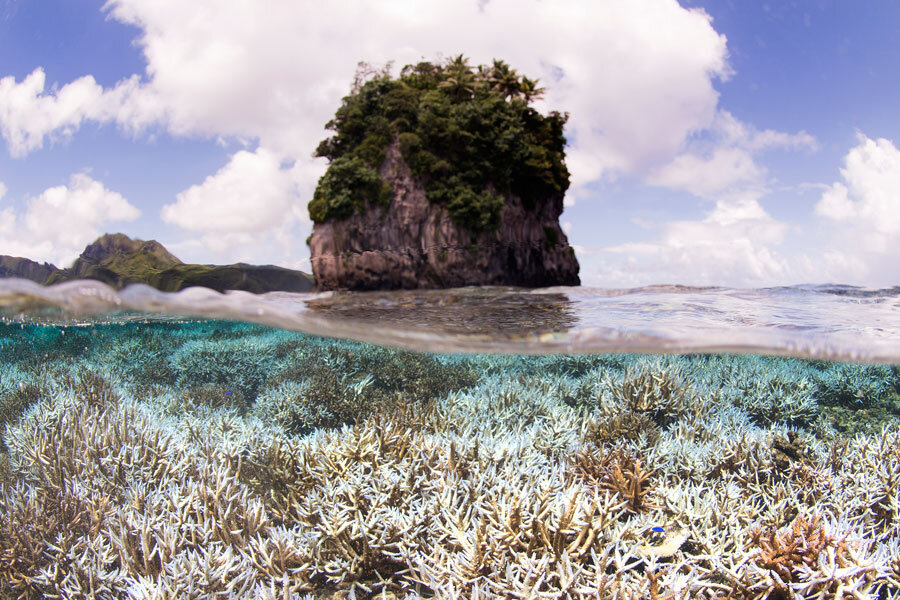'The Blob': As warm water kills off coral reefs, can we help?
Coral reefs are suffering from a massive oceanic heat wave for the third time on record, and scientists fear it could be the biggest die-off yet.
Experts at the US National Oceanic and Atmospheric Administration (NOAA) said they have only witnessed similar events twice before, first in 1998 and then in 2010. But since the early 1980s, scientists claim the world has lost half of its coral reefs.
The record-high ocean temperatures are expected to kill about five percent, or 4,600 square miles, of the world’s coral reefs. And this would be a good outcome, Dr. Mark Eakin, coordinator at NOAA’s Coral Reef Watch, told The Christian Science Monitor. "Unfortunately, the five percent number takes into account the hope that about 60 percent of the reefs that are hit hard this year bounce back," he says.
The immediate future for coral reefs looks especially bleak because a strong El Nino is coinciding with the phenomenon known as ‘The Blob,’ a patch of particularly warm water moving throughout the northwestern Pacific Ocean.
“It's not well understood how much of ‘The Blob’ is related to climate change…It’s still a bit of a mystery,” Dr. Eakin told Reuters. And although the Blob’s origins are still a mystery, its impact on the world’s coral reefs is not.
When corals are under stress from events such as warming ocean temperature, they drive out the symbiotic algae that give the coral its color and nutrients. Bleaching is a "survival mechanism," Eakin explains to the Monitor, "because when temperatures get too high, the algae photosynthesize too fast and release toxins into the coral." And although bleaching does not immediately kill the coral, it makes the underwater creatures very vulnerable, thus increasing the likelihood of an extensive die-off.
Dr. Ove Hoegh-Guldberg, director of the Global Change Institute at the University of Queensland, Australia, says the best way to prevent coral bleaching is to focus on the coral’s other stressors, such as overfishing and pollution. “If you’ve got a chronic disease, then you are more sensitive to a lot of other things and if you want a recovery then you need to take all those other stresses off,” Dr. Hoegh-Guldberg explained to the Guardian.
Hoegh-Guldberg says global and local action could really make a difference. “If we were to take strong action on the emission issue and we were to take strong action on the non-climate issues such as overfishing and pollution, reefs would rebound by mid to late century,” he told The Guardian.
When asked if conflicting priorities at the international level prevent effective protection, Eakin told the Monitor that international relations should not play a factor in coral reef protection. "The tragedy of the commons is a big problem, but all coral reefs are within countries’ national waters," he says. "The international action we need now is a strong climate agreement coming out of the COP21 in Paris this December."
Other experts say we need to invest our resources in satellite monitoring technology to build data the various stages of the bleaching process. The XL Catlin Seaview Survey, a scientific expedition by the University of Queensland and Underwater Earth to study reef changes, uses a SVII camera on an underwater scooter to capture high-resolution, 360-degree underwater images in an area up to 1.2 miles.
“By supporting our efforts with technology that helps us map where bleaching is occurring, we can facilitate the research necessary to understand this phenomenon and determine the impact,” Richard Vevers, executive director of the XL Catlin Seaview Survey, said in a press release.
Some marine scientists argue the next realistic step involves deciding which reefs should be a priority for cash-strapped conservation managers.
Australian marine scientist Dr. Nicholas Graham and his colleagues devised a simple way of predicting which reefs “stand the best change of recovery from a climate-triggered bleaching event,” and he explained the results of his study to The Christian Science Monitor in June. Dr. Graham and his colleagues found that they could “successfully predict a reef’s recovery trajectory 98 percent of the time” by comparing reef complexity and water depth.






